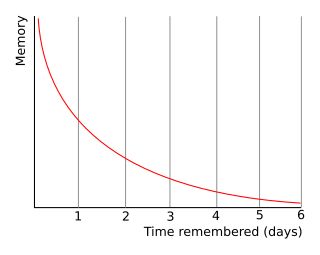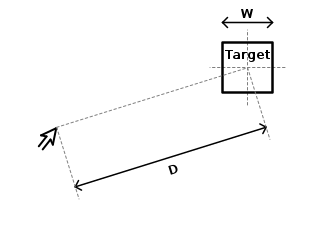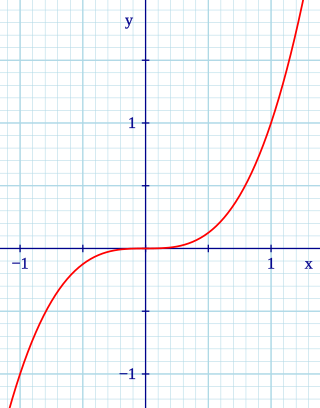
Cognitive psychology is the scientific study of mental processes such as attention, language use, memory, perception, problem solving, creativity, and reasoning.

The forgetting curve hypothesizes the decline of memory retention in time. This curve shows how information is lost over time when there is no attempt to retain it. A related concept is the strength of memory that refers to the durability that memory traces in the brain. The stronger the memory, the longer period of time that a person is able to recall it. A typical graph of the forgetting curve purports to show that humans tend to halve their memory of newly learned knowledge in a matter of days or weeks unless they consciously review the learned material.

Fitts's law is a predictive model of human movement primarily used in human–computer interaction and ergonomics. The law predicts that the time required to rapidly move to a target area is a function of the ratio between the distance to the target and the width of the target. Fitts's law is used to model the act of pointing, either by physically touching an object with a hand or finger, or virtually, by pointing to an object on a computer monitor using a pointing device. It was initially developed by Paul Fitts.

Attention is the concentration of awareness on some phenomenon to the exclusion of other stimuli. It is a process of selectively concentrating on a discrete aspect of information, whether considered subjective or objective. William James (1890) wrote that "Attention is the taking possession by the mind, in clear and vivid form, of one out of what seem several simultaneously possible objects or trains of thought. Focalization, concentration, of consciousness are of its essence." Attention has also been described as the allocation of limited cognitive processing resources. Attention is manifested by an attentional bottleneck, in terms of the amount of data the brain can process each second; for example, in human vision, only less than 1% of the visual input data can enter the bottleneck, leading to inattentional blindness.

Psychology is an academic and applied discipline involving the scientific study of human mental functions and behavior. Occasionally, in addition or opposition to employing the scientific method, it also relies on symbolic interpretation and critical analysis, although these traditions have tended to be less pronounced than in other social sciences, such as sociology. Psychologists study phenomena such as perception, cognition, emotion, personality, behavior, and interpersonal relationships. Some, especially depth psychologists, also study the unconscious mind.
A learning curve is a graphical representation of the relationship between how proficient people are at a task and the amount of experience they have. Proficiency usually increases with increased experience, that is to say, the more someone, groups, companies or industries perform a task, the better their performance at the task.
Procedural knowledge is the knowledge exercised in the performance of some task. Unlike descriptive knowledge, which involves knowledge of specific facts or propositions, procedural knowledge involves one's ability to do something. A person doesn't need to be able to verbally articulate their procedural knowledge in order for it to count as knowledge, since procedural knowledge requires only knowing how to correctly perform an action or exercise a skill.
The interference theory is a theory regarding human memory. Interference occurs in learning. The notion is that memories encoded in long-term memory (LTM) are forgotten and cannot be retrieved into short-term memory (STM) because either memory could interfere with the other. There is an immense number of encoded memories within the storage of LTM. The challenge for memory retrieval is recalling the specific memory and working in the temporary workspace provided in STM. Retaining information regarding the relevant time of encoding memories into LTM influences interference strength. There are two types of interference effects: proactive and retroactive interference.
Hick's law, or the Hick–Hyman law, named after British and American psychologists William Edmund Hick and Ray Hyman, describes the time it takes for a person to make a decision as a result of the possible choices: increasing the number of choices will increase the decision time logarithmically. The Hick–Hyman law assesses cognitive information capacity in choice reaction experiments. The amount of time taken to process a certain amount of bits in the Hick–Hyman law is known as the "rate of gain of information". The plain language implication of the finding is that increasing the number of choices does not directly increase the time to choose. In other words, twice as many choices does not result in twice as long to choose. Also, because the relationship is logarithmic, the increase in time it takes to choose becomes less and less as the number of choices increases.
ACT-R is a cognitive architecture mainly developed by John Robert Anderson and Christian Lebiere at Carnegie Mellon University. Like any cognitive architecture, ACT-R aims to define the basic and irreducible cognitive and perceptual operations that enable the human mind. In theory, each task that humans can perform should consist of a series of these discrete operations.
Cognitive apprenticeship is a theory that emphasizes the importance of the process in which a master of a skill teaches that skill to an apprentice.

Mathematical psychology is an approach to psychological research that is based on mathematical modeling of perceptual, thought, cognitive and motor processes, and on the establishment of law-like rules that relate quantifiable stimulus characteristics with quantifiable behavior. The mathematical approach is used with the goal of deriving hypotheses that are more exact and thus yield stricter empirical validations. There are five major research areas in mathematical psychology: learning and memory, perception and psychophysics, choice and decision-making, language and thinking, and measurement and scaling.
John Robert Anderson is a Canadian-born American psychologist. He is currently professor of Psychology and Computer Science at Carnegie Mellon University.

Mental chronometry is the scientific study of processing speed or reaction time on cognitive tasks to infer the content, duration, and temporal sequencing of mental operations. Reaction time is measured by the elapsed time between stimulus onset and an individual's response on elementary cognitive tasks (ETCs), which are relatively simple perceptual-motor tasks typically administered in a laboratory setting. Mental chronometry is one of the core methodological paradigms of human experimental, cognitive, and differential psychology, but is also commonly analyzed in psychophysiology, cognitive neuroscience, and behavioral neuroscience to help elucidate the biological mechanisms underlying perception, attention, and decision-making in humans and other species.
Psychomotor learning is the relationship between cognitive functions and physical movement. Psychomotor learning is demonstrated by physical skills such as movement, coordination, manipulation, dexterity, grace, strength, speed—actions which demonstrate the fine or gross motor skills, such as use of precision instruments or tools, and walking. Sports and dance are the richest realms of gross psychomotor skills.

The plateau effect is a phenomenon that lessens the effectiveness of once effective measures over time. An example of the plateau effect is when someone's exercise fails to be as effective as in the past, similar to the concept of diminishing returns. A person enters into a period where there is no improvement or a decrease in performance.
Procedural memory is a type of implicit memory which aids the performance of particular types of tasks without conscious awareness of these previous experiences.
The challenge point framework, created by Mark A. Guadagnoli and Timothy D. Lee (2004), provides a theoretical basis to conceptualize the effects of various practice conditions in motor learning. This framework relates practice variables to the skill level of the individual, task difficulty, and information theory concepts. The fundamental idea is that “motor tasks represent different challenges for performers of different abilities”. Any task will present the individual with a certain degree of challenge. However, the learning potential from this task difficulty level will differ based on the:
Skill-based theories of second-language acquisition are theories of second-language acquisition based on models of skill acquisition in cognitive psychology. These theories conceive of second-language acquisition as being learned in the same way as any other skill, such as learning to drive a car or play the piano. That is, they see practice as the key ingredient of language acquisition. The most well-known of these theories is based on John Anderson's adaptive control of thought model.
Human performance modeling (HPM) is a method of quantifying human behavior, cognition, and processes. It is a tool used by human factors researchers and practitioners for both the analysis of human function and for the development of systems designed for optimal user experience and interaction. It is a complementary approach to other usability testing methods for evaluating the impact of interface features on operator performance.






